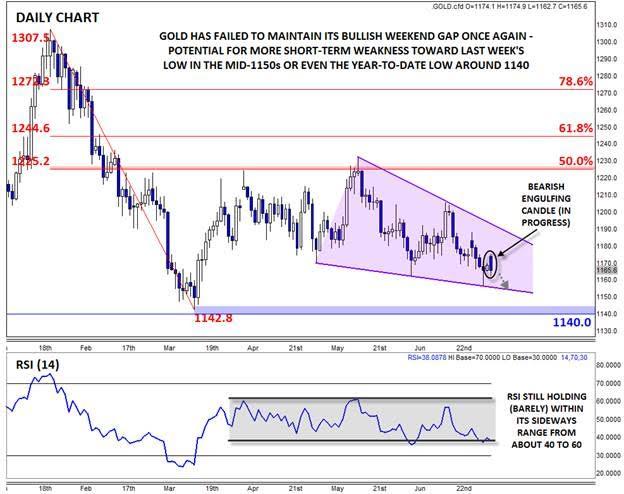![]()
Last week, we analyzed the (lack of) safe haven demand for gold in the wake of Greece’s deteriorating debt negotiations, noting that “the yellow metal …[was] dramatically lagging its safe-haven rivals” and that “this week’s lackluster reaction suggests that gold may be losing its luster and on the verge of a big breakdown” (see “Gold: Safe Haven No More?”). Gold subsequently dropped to a new nearly 4-month low at 1156 on Thursday before recovering slightly into the weekend.
As we open another week of trade, it feels a bit like the 1993 movie “Groundhog Day,” where Bill Murray inexplicably get caught in a time loop and is forced to relive the same day over and over again. Much like in that iconic movie, this week’s moves in gold closely mirror last week’s: the yellow metal gapped slightly higher to start this week after an ostensibly negative development in Greece’s debt negotiations. However, the small bullish gap has already been filled and gold is once again trading below Friday’s open. Gold’s failure to retain any sort of safe-haven bid despite increasing global economic uncertainty represents a strong bearish signal moving forward.
From a technical perspective, gold is working on a potential Bearish Engulfing Candle* on the daily chart, signaling a big shift to selling pressure. Unless we see a rally during today’s US session, this candlestick pattern will suggest a possible continuation down toward last week’s low in the mid-1150s.
The medium-term picture is a bit more constructive, with gold’s RSI indicator still holding within its sideways range and the price of the metal itself forming a falling wedge pattern; despite its ominous-sounding name, this pattern could actually lead to a rally if gold is able to overcome the upper trend line near 1190. For now though, the near-term bias in gold remains lower, with strong support sitting at the year-to-date lows near 1140.
*A Bearish Engulfing candle is formed when the candle breaks above the high of the previous time period before sellers step in and push rates down to close below the low of the previous time period. It indicates that the sellers have wrested control of the market from the buyers.
This research is for informational purposes and should not be construed as personal advice. Trading any financial market involves risk. Trading on leverage involves risk of losses greater than deposits.
Recommended Content
Editors’ Picks
EUR/USD holds above 1.0700 ahead of key US data

EUR/USD trades in a tight range above 1.0700 in the early European session on Friday. The US Dollar struggles to gather strength ahead of key PCE Price Index data, the Fed's preferred gauge of inflation, and helps the pair hold its ground.
USD/JPY stays above 156.00 after BoJ Governor Ueda's comments

USD/JPY holds above 156.00 after surging above this level with the initial reaction to the Bank of Japan's decision to leave the policy settings unchanged. BoJ Governor said weak Yen was not impacting prices but added that they will watch FX developments closely.
Gold price oscillates in a range as the focus remains glued to the US PCE Price Index

Gold price struggles to attract any meaningful buyers amid the emergence of fresh USD buying. Bets that the Fed will keep rates higher for longer amid sticky inflation help revive the USD demand.
Sei Price Prediction: SEI is in the zone of interest after a 10% leap

Sei price has been in recovery mode for almost ten days now, following a fall of almost 65% beginning in mid-March. While the SEI bulls continue to show strength, the uptrend could prove premature as massive bearish sentiment hovers above the altcoin’s price.
US core PCE inflation set to signal firm price pressures as markets delay Federal Reserve rate cut bets

The core PCE Price Index, which excludes volatile food and energy prices, is seen as the more influential measure of inflation in terms of Fed positioning. The index is forecast to rise 0.3% on a monthly basis in March, matching February’s increase.
